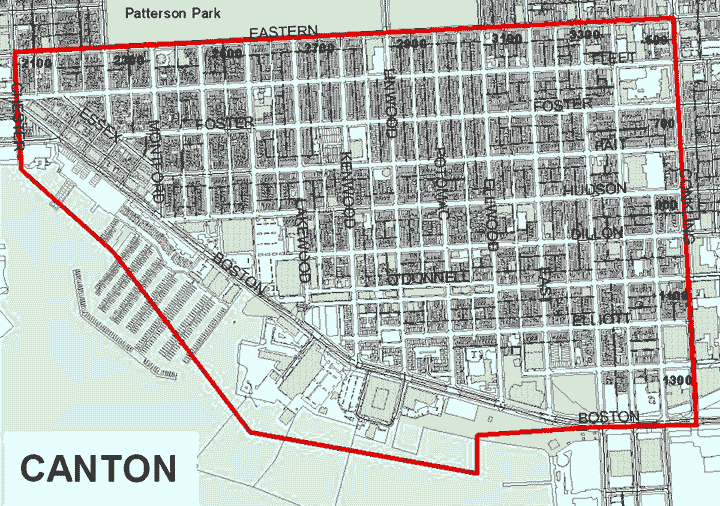Canton
National Register of Historic Places 1/29/80
Certified Historic District for Tax Incentives (NR)
Description
 The Canton Historic District is in East Baltimore just east of Fells Point and south of Patterson Park. Extending over nearly 100 blocks of shoreline housing and industry, Canton is one of the largest historic districts in Baltimore. The district is primarily comprised of 19th and early 20th century Baltimore style row houses. There is a great diversity of house types in Canton, ranging from the early 19th century red brick, small gabled-roof house, to the 20th century tan brick, white marble step house built in large rows.
The Canton Historic District is in East Baltimore just east of Fells Point and south of Patterson Park. Extending over nearly 100 blocks of shoreline housing and industry, Canton is one of the largest historic districts in Baltimore. The district is primarily comprised of 19th and early 20th century Baltimore style row houses. There is a great diversity of house types in Canton, ranging from the early 19th century red brick, small gabled-roof house, to the 20th century tan brick, white marble step house built in large rows.
The residential area is structured along a grid pattern of north-south and east-west streets. Cambridge and Essex Street break this grid with a diagonal pattern. In addition to the residential development there is a commercial area along Eastern Avenue and a market square at O'Donnell Street. Industrial buildings are generally located along the southern perimeter of the district on the harbor. Among the more notable structures in Canton are Saint Casmir's Church and Canton's branch of the Enoch Pratt Free Library.
Significance
Canton has played an important role in the development of Baltimore's early maritime trade and the City's growth as a major port. This district is one of the oldest industrial development communities in the United States. In 1828 New York capitalist Peter Cooper purchased three thousand acres along the shoreline near Fells Point (Canton) for $105,000. Large companies primarily in the canning, packing, and fertilizing industries migrated here throughout the 19th century.
A unique relationship developed between Canton's industries and the residential areas that grew up around the industries. Many of the industries built worker's housing and provided for the social welfare and recreational needs of their workers. This paternal relationship was generally maintained until the growth of trade unions in the early 20th century. The Canton area is also associated with the growth of Baltimore's ethnic communities. A community of Welsh copper workers developed here as early as 1850. Germans and Irishmen settled in Canton in the latter half of the 20th century. By the turn of the century a large Polish community developed. These groups have played an important role in the development of Canton and Baltimore's port-related industries.